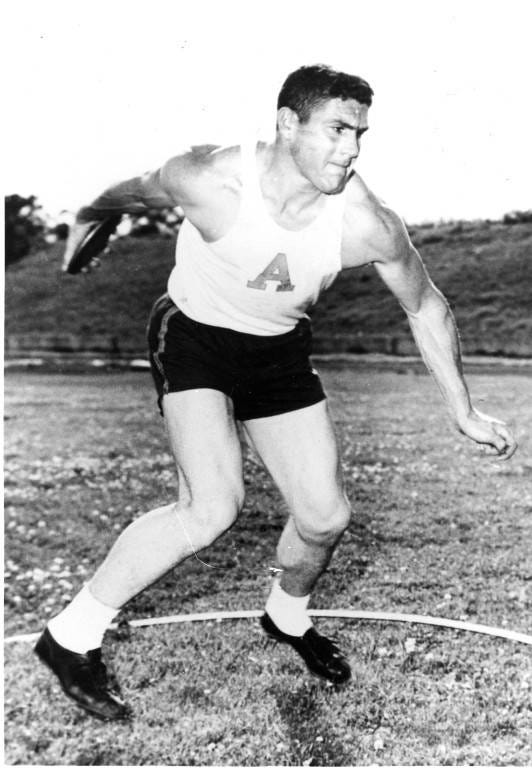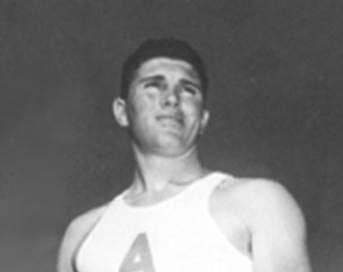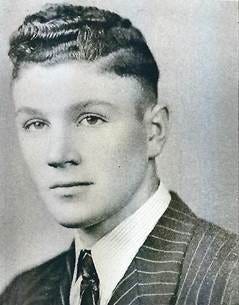Seventeen men from across the globe made the finals in the discus throw at the 1952 Olympics in Helsinki, Finland. Men that would break national, Olympic and world records. Men that were national heroes and household names in their respective countries. Men that were from some of the largest population centers of the time. And among them was a farmer from Harpster, Ohio, named James Dillion.
You’d be forgiven for never having heard of the town of Harpster before. The population has been under 300 in every census but one. The high school closed in 1961 when it was absorbed by county seat Upper Sandusky. Graduating classes were often in the single digits. In fact, in 1947 when Dillion graduated, there were only six seniors. His own yearbook didn’t even mention his state championship in the shot put. Given the circumstances it is no surprise James did not attend college after high school but instead enlisted in the Army.
During his time in the service James was a standout athlete and often the most athletic on the post. At Fort Belvoir in Virginia he set a base record of a throw over 150 feet in the discus. He was then stationed at Fort Still in Oklahoma where he first learned the game of football. He became the starting defensive end and caught the eye of Capt. Ernest Mills who played at Auburn in 1940. Although he received offers from Ohio State, Oklahoma and West Point, James ultimately chose Auburn where he enrolled as an aeronautical engineer student.
His arrival at Auburn was met with much intrigue and mystery. He came to to campus on a football scholarship but quickly joined the track and field team. He was the only “yankee” to star for Auburn and he instantly gained a reputation on campus. Dillion had the university community buzzing about his impressive size and physique. He ended up earning the nickname “hamhock” due to the size of his hands being the size of a pork knuckle. As a freshman, Dillion was forced to compete for the freshmen team as freshmen were not allowed to compete in varsity competition at the time. In a freshmen meet against Georgia Tech, James actually broke the would-have-been SEC record in the discus but he was ineligible to compete at the SEC Championships.

Dillion actually started playing sports at Auburn in the spring of 1950. That meant in the fall he would still have to play for the freshmen football team. He did well on the year and was regarded as one of the top prospects on the team. He also ended up on the freshman basketball team as well. However, now that he was officially a sophomore in track and field, he could break out on the big stage. In his very first varsity meet at the Florida Relays, Dillion won the discus with a throw of 164 feet and 8 inches and broke the school record. He then followed that up with a second place finish in the shot put where he finished only an inch behind the defending SEC champion. He then followed that up with two firsts at the Southern Relays by beating the defending SEC champion in both the shot put and the discus. A week after that he broke the school record in the shot put.
James was in world class form going into championship season. Heading into the SEC Championships he had the top discus throw in the USA on the year. He finally broke the official conference record with a toss of 161 feet and 9.5 inches to take the gold. Dillion went into the NCAA Championship meet as the top performer in the country and he showed no doubt he was the best. He defeated defending Olympic gold medalist in the decathlon Bob Mathias by just under three inches to win the title. He ended the year ranked 5th in the world in the discus.
The following season Dillion chose not to compete for the football and basketball squads anymore and instead focus his time on track & field. He again started the year off strong with a shot put and discus win at the Florida Relays. He then followed that up by heaving the discus over 171 feet 4 inches to set a new Southern Relays record. Dillion then defended his SEC title with another conference record throw, this time at 164 feet and 6.5 inches. However, at the NCAA championship meet he faltered, finishing fourth place with a throw of 167 feet and 4 inches. Almost six feet behind the champion Sim Iness.
Dillion need to rebound and he did so almost immediately. He turned around and won the United States Championships (AAU) and put himself back into the running for the Olympics. At his next meet, the Olympic Trials, he would have to finish in the top three to qualify. Sim Iness and Foturne Gordien took the top two spots. And with a throw of of 173 feet and 1 inch Jim Dillion booked his ticket to Helsinki with a third place finish.
The world class field and high stakes were never something that got to Dillion’s head. He was calm and collected and performed when he needed to. To qualify for the finals Dillion had to throw over 150 feet and 11 inches in the preliminaries. He threw 157 feet and 2 inches on his first attempt. In the finals Dillion threw 172 feet and 1 inch to best the previous Olympic Record. However, Sim Iness then threw 175 feet and 5 inches. Then, the previous Olympic champion Adolfo Consolini of Italy threw the discus 176 feet and 5 inches. And fellow countrymen Fortune Gordien bested Dillion’s mark by eight inches to move him down to fourth. On his third throw, Sim Iness went even farther with another Olympic Record throw of 180 feet 6 inches. On Dillion’s fourth throw he took his best heave of the day with a throw of 174 feet and 9 inches to catapult himself into the bronze medal position. Fortune Gordien couldn’t keep up and the farmer from Harpster, Ohio was officially an Olympic medalist.
This wasn’t it for James Dillion. He returned to Auburn and finally played football at the varsity level where he was a linebacker. He ended up with chronic knee pain which forced him to sit out the 1953 track and field season. As a senior in 1954 he bounced back onto the track and field scene with a win at the Southern Relays to start the season. He then continued his SEC record breaking ways by throwing a new conference record of 171 feet and 4 inches. He also captured his first ever SEC shot put crown with a throw of 50 feet and half an inch. In a meet before the NCAA Championships, Dillion would have the best throw of his life with a toss of 180 feet and 8 inches. An Auburn record that would stand for 45 years. He would then clobber the competition at the NCAA Championships to earn his second title and winning by nearly seven feet. He would then go to finish third at the USA Championships.
And that’s how a farmer from Harpster, Ohio became an Olympian in Helsinki, Finland.






